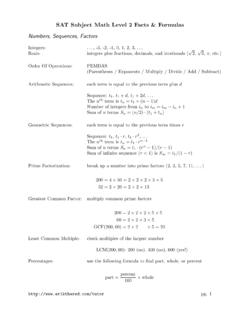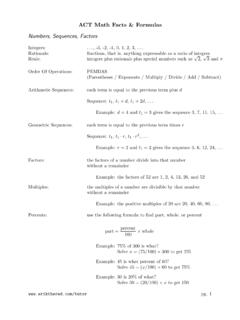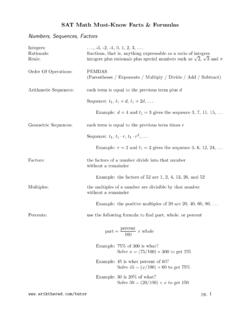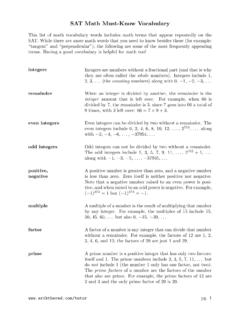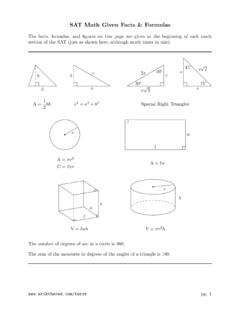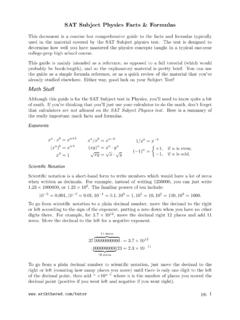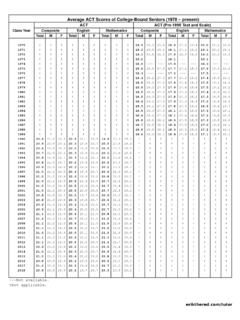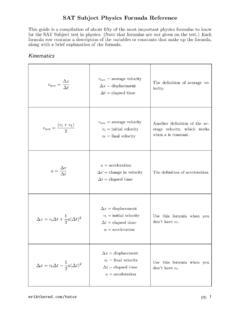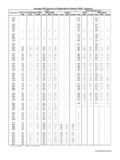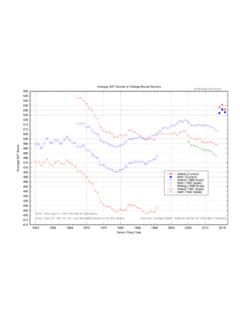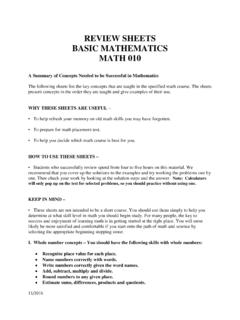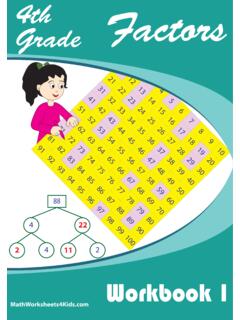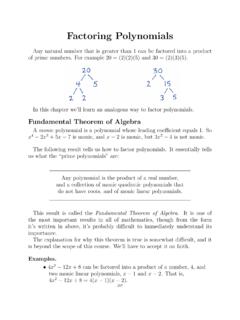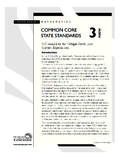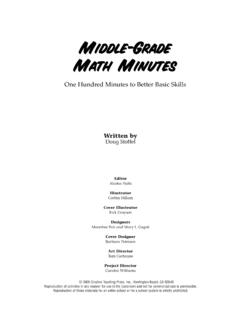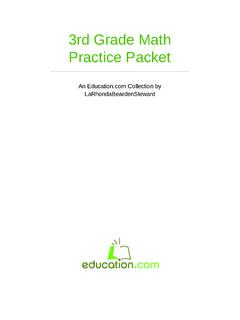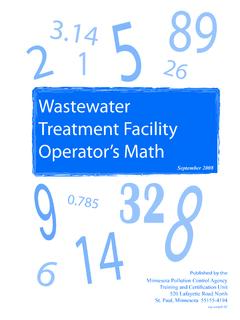Transcription of SAT Math Must-Know Facts & Formulas Numbers, …
1 SAT math Must-Know Facts & FormulasNumbers, Sequences, FactorsIntegers:.., -3, -2, -1, 0, 1, 2, 3,..Rationals:fractions, that is, anything expressable as a ratio of integersReals:integers plus rationals plus special numbers such as 2, 3 and Order Of Operations:PEMDAS(Parentheses / Exponents / Multiply / Divide / Add / Subtract)Arithmetic Sequences:each term is equal to the previous term plusdSequence:t1,t1+d,t1+ 2d,..Example:d= 4 andt1= 3 gives the sequence 3, 7, 11, 15,..Geometric Sequences:each term is equal to the previous termtimesrSequence:t1,t1 r,t1 r2,..Example:r= 2 andt1= 3 gives the sequence 3, 6, 12, 24,.. factors :the factors of a number divide into that numberwithout a remainderExample: the factors of 52 are 1, 2, 4, 13, 26, and 52 Multiples:the multiples of a number are divisible by that numberwithout a remainderExample: the positive multiples of 20 are 20, 40, 60, 80.
2 Percents:use the following formula to find part, whole, or percentpart =percent100 wholeExample: 75% of 300 is what?Solvex= (75/100) 300 to get 225 Example: 45 is what percent of 60?Solve 45 = (x/100) 60 to get 75%Example: 30 is 20% of what?Solve 30 = (20/100) xto get 1 SAT math Must-Know Facts & FormulasAverages, Counting, Statistics, Probabilityaverage =sum of termsnumber of termsaverage speed =total distancetotal timesum = average (number of terms)mode = value in the list that appears most oftenmedian = middle value in the list (whichmustbe sorted)Example: median of{3,10,9,27,50}= 10 Example: median of{3,9,10,27}= (9 + 10)/2 = Counting Principle:If an event can happen inNways, and another, independent eventcan happen inMways, then both events together can happen inN :probability =number of desired outcomesnumber of total outcomesExample.
3 Each SAT math multiple choice question hasfive possible answers, one of which is the correct you guess the answer to a question completely at ran-dom, your probability of getting it right is 1/5 = 20%.The probability of two different eventsAandBbothhappening isP(AandB) =P(A) P(B), as long as the events are independent(not mutually exclusive).Powers, Exponents, Rootsxa xb=xa+b(xa)b=xa bx0= 1xa/xb=xa b(xy)a=xa ya xy= x y1/xb=x b( 1)n={+1,ifnis even; 1,ifnis 2 SAT math Must-Know Facts & FormulasFactoring, Solving(x+a)(x+b) =x2+ (b+a)x+ab FOIL a2 b2= (a+b)(a b) Difference Of Squares a2+ 2ab+b2= (a+b)(a+b)a2 2ab+b2= (a b)(a b)To solve a quadratic such asx2+bx+c= 0, first factor the left side to get (x+a1)(x+a2) =0, then set each part in parentheses equal to zero.}
4 ,x2+ 4x+ 3 = (x+ 3)(x+ 1) = 0so thatx= 3 orx= solve two linear equations inxandy: use the first equation to substitute for a variablein the second. , supposex+y= 3 and 4x y= 2. The first equation givesy= 3 x,so the second equation becomes 4x (3 x) = 2 5x 3 = 2 x= 1, y= function is a rule to go from one number (x) to another number (y), usually writteny=f(x).For any given value ofx, there can only be one corresponding valuey. Ify=kxfor somenumberk(example:f(x) = x), thenyis said to bedirectly proportionaltox. Ify=k/x(example:f(x) = 5/x), thenyis said to beinversely value:|x|={+x,ifx 0; x,ifx < (Linear Functions)Consider the line that goes through pointsA(x1, y1) andB(x2, y2).Distance fromAtoB: (x2 x1)2+ (y2 y1)2 Mid-point of the segmentAB:(x1+x22,y1+y22)Slope of the line:y2 y1x2 x1= 3 SAT math Must-Know Facts & FormulasSlope-intercept form: given the slopemand the y-interceptb, then the equation of theline isy=mx+b.}
5 Parallel lines have equal slopes:m1=m2. Perpendicular lines havenegative reciprocal slopes:m1 m2= b a b mla b a b a b a b Intersecting LinesParallel Lines (lkm)Intersecting lines: opposite angles are equal. Also, each pair of angles along the same lineadd to 180 . In the figure above,a+b= 180 .Parallel lines: eight angles are formed when a line crosses two parallel lines. The four bigangles (a) are equal, and the four small angles (b) are triangles:abcx 3x2x30 60 xxx 245 45 a2+b2=c2 Special Right TrianglesNote that the above special triangle figures are given in the test booklet, so you don t haveto memorize them, but you should be familiar with what they mean, especially the firstone, which is called the Pythagorean Theorem (a2+b2=c2).
6 A good example of a right triangle is one witha= 3,b= 4, andc= 5, also called a 3 4 5right triangle. Note that multiples of these numbers are also right triangles. For example,if you multiply these numbers by 2, you geta= 6,b= 8, andc= 10 (6 8 10), which isalso a right Special Right Triangles are needed less often than thePythagorean Theorem. Here, x is used to mean any positive number, such as 1, 1/2, etc. A typical example on thetest: you are given a triangle with sides 2, 1, and 3 and are asked for the angle oppositethe 3. The figure shows that this angle is 60 . 4 SAT math Must-Know Facts & FormulasAll triangles:hbArea =12 b hThe area formula above works foralltriangles, not just right on the inside of any triangle add up to 180.
7 The length of one side of any triangle is alwayslessthan the sum of the lengths of theother two important triangles:Equilateral: These triangles have three equal sides, and all three angles are 60 .Isosceles:An isosceles triangle has two equal sides. The base angles(the ones opposite the two sides) are equal. A good example ofanisosceles triangle is the one on page 4 with base angles of 45 .Similar:Two or more triangles are similar if they have the same shape. Thecorresponding angles are equal, and the corresponding sidesare in proportion. For example, the 3 4 5 triangle and the 6 8 10triangle from before are similar since their sides are in a ratio of 2 to (h, k)rn rArcSectorArea = r2 Circumference = 2 rFull circle = 360 (Optional)Length Of Arc = (n /360 ) 2 rArea Of Sector = (n /360 ) 5 SAT math Must-Know Facts & FormulasRectangles And FriendslwhlwRectangleParallelogram (Optional)(Square ifl=w)(Rhombus ifl=w)Area =lwArea =lhThe formula for the area of a rectangle is given in the test booklet, but it is very importantto know, so you should memorize it SolidRight CylinderVolume =lwhVolume = r2hNote that the above solids figures are given in the test booklet, so you don t have tomemorize them, but you should be familiar with what they 6
